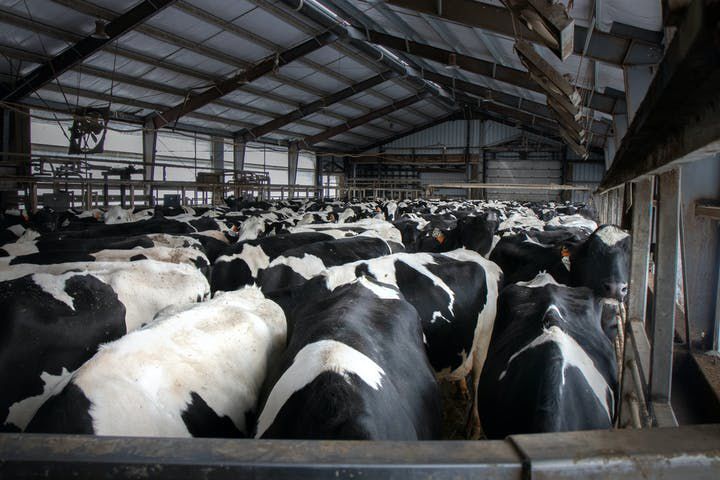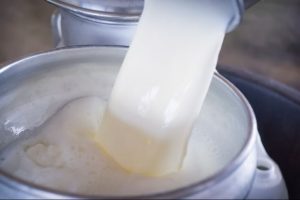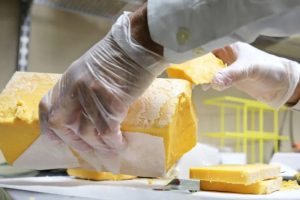
As the general manager of a Wisconsin-based cooperative with members in seven states, Jeff Lyon senses feelings of anxiety and uncertainty. The individual moods of FarmFirst Dairy Cooperative members have less to do with herd size and are more dependent on where they are in their careers, their financial situations and whether they have children joining their operation.
Due to the coronavirus pandemic, 2020 turned into a bumpy ride for many of the co-op’s members, located in Wisconsin, Minnesota, South Dakota, Michigan, Iowa, Illinois and Indiana. However, government programs helped bridge some of those potholes and hazards along the way.
“While a roller coaster with respect to milk price, 2020 was an overall good income year for dairy farmers thanks to government payments,” said Lyon. Indemnity payments through the Dairy Margin Coverage (DMC) program and direct assistance through the Coronavirus Food Assistance Program (CFAP) program helped many producers improve their financial situations.
Expecting similar levels of government aid to continue in 2021 isn’t realistic, Lyon warned. The year is expected to be financially challenging, especially for those who have not adequately covered their bottom lines with risk management options.
Despite its challenges, positives coming out of 2020 will serve the dairy industry well. Market disruptions caused by the pandemic brought to light the strength of the U.S. dairy industry, according to Lyon.
“It was remarkable how our dairy processors quickly changed product packaging for retail in grocery stores when restaurants and other food service business shuttered their doors last spring,” he said. “It quickly came to light that the United States has a world-class production, processing and transportation system, considering the number of changes made across the entire food sector.”
At the producer level, realization of the need to manage risk led to increased exploration and use of available tools. “Farming is no longer just about caring for your cows and tending to crops; it’s about being savvy about your market and protecting yourself and your business,” Lyon said.
Looking ahead, Lyon said increasing milk production will require more product innovation to meet the demands of consumers in an effort to grow per-capita consumption. Production that can’t be absorbed domestically will make exports even more critical to maintain higher milk prices.
Adding to dairy’s challenges are both the scope and speed of changing preferences and market conditions of consumers both home and abroad. And the pandemic has also caused another change in the supply chain: the need for more “on time demand,” Lyon said. That’s led to more fluctuation in both the volume and timing of deliveries.
Regulatory oversight is expected to increase. Lyon said he believes there are solid relationships in place to ensure dairy farmers are well represented on policy and economic issues going forward.
“It will be imperative that the dairy industry continue to tell our story of all the good things the industry has been doing for years with respect to land stewardship and water quality,” Lyon said. “Further, we will need to heavily combat the exaggerated claims regarding the dairy industry’s impact on the climate.”
Lyon identifies the need for reforms on several fronts. “While they do not all come under federal order reform, actions are needed to minimize impacts of the large spread between block and barrel cheese prices, reform procedures, structures and the general oversight of the Chicago Mercantile Exchange cheese markets, given the importance of the CME as a price discovery tool affecting milk prices more broadly. The Class I mover issue, while not as much importance to the Upper Midwest because of our low Class I utilization, needs to be addressed,” he said.
Wilson: Policy focus must be on supply
For Bobbi Wilson, policy and special projects coordinator with the Wisconsin Farmers Union (WFU), the overall uncertainty entering 2021 varies by producer and can change almost daily, driven by a mix of hopefulness for better things to come and a jaded outlook from those who have spent decades facing deep structural issues in the dairy industry.
Federal aid stemmed the tide of farm losses in 2020. However, anticipating a decline or reduction in financial assistance – under the backdrop of overproduction and continued market disruptions due to the pandemic – Wilson fears milk prices will not be sufficient to sustain small- and medium-sized dairy farms, accelerating the rate of those producers exiting dairy.
“Dairy producers have been treading water over the last year, kept afloat primarily by government purchases and payments,” said Wilson, noting that Wisconsin was among the nation’s leaders in farm bankruptcy filings last year. “It’s important we industry players don’t just view those numbers passively – we must recognize the chipping away of the industry that is happening and the real-life impact on farm families,” she said.
For Wilson, one positive coming out of 2020 was widespread recognition that supply management – as processors implemented base-excess plans to curb overproduction and prevent milk dumping – can work. While co-ops and processors should continue those programs, her organization has been the leader of the “Dairy Together” movement, pushing for federal policies that includes mandatory supply management, milk pricing reforms and efforts to discourage industry consolidation.
“Federal order reform should provide a way for dairy producers to capture the value of their product,” she said. “Much of the profits are siphoned off in processing, distribution and retail, and farmers receive a shrinking share of the retail food dollar while their input costs keep going up.”
Wilson said organizations must differentiate between advocating for the interests of the farmer and those who are advocating for the interests of the industry.
“We cannot deny the big money and lobbying power behind industry interests, and too often we’ve seen their interests rise above those of the American farmer,” she said. “The passion our dairy farmer members have for their way of life, their animals and for being innovative, even through the ups and downs, is inspiring. We as an industry and as farm organizations representing these folks can refuel off that passion; I hope it can push us – and unite us – to find some real solutions to some of the big issues the industry is facing.”
Memories leave lasting effects
Matt Lange, a dairy consultant at Compeer Financial, finds a mix of uncertainty, anxiety and trepidation among the dairy farmers he works with.
Higher milk prices and government payments provided more working capital and much stronger liquidity to start 2021. Many operations made pre-payments that should allow them to balance swings in cash flows better than in most years. However, even though many of his clients are in their best financial positions since 2014, memories of the past four to five years leave an uneasy feeling, he said.
With that mindset, Lange doesn’t foresee large growth in cow numbers in the year ahead, although milk and component production per cow are on the rise. “I currently do not have many large expansions in the pipeline. Those that are planned have been placed on hold due to the availability of materials and their cost,” he said.
A light at the end of the tunnel is the potential of bringing COVID-19 and its impact on dairy markets under control.
“The general economy has been exceeding most expectations and consumer preferences have shifted, but dairy has fared well in most respects,” Lange said. “We are also coming off of a great growing season for most, and new-crop corn silage appears to be feeding out well in most parts, so milk production should be fairly strong going forward this year.”
Things he’s watching in 2021 include weather volatility, potential regulation, changes in consumer trends, the global economy and a sudden rise in cropping input and feed costs. If these variables collide with others, it may cause even greater instability, he warned.
Combining financial with weather terminology, Lange said more intense “wind sheers” or “sudden thunderstorms” will create the greatest obstacles going forward. Some of those were evident in 2020: the suddenness of the shutdown of food service channels, record-high Class III prices due to cheese purchases that were followed by negative producer price differentials (PPDs), the government response in direct aid which was beneficial to farmers’ bottom line but now creates a new level of uncertainty.
“Black swans can now converge on each other to heighten and extend the levels of volatility to the producer,” he said.
Although many agree Federal Milk Marketing Order (FMMO) reform is necessary, Lange said the changes must take into account potentially good and negative regional consequences.
A lender’s perspective
As a resident of Wisconsin, Sam Miller has had a close-up view of dairy’s mood swings over the years. As managing director and group head of agricultural banking for BMO Harris Bank, he sees the general mood entering 2021 as one of “relief.” The election is over, vaccines are being rolled out, cash flow and balance sheets are in better shape, and last year’s crop harvest has provided adequate feed supplies.
Like Lange, Miller said the positive side of the ledger is lengthy. Feed companies, veterinarians and other suppliers saw accounts receivable get caught up. Dairy farmers used funds to improve working capital, pay down or pay off lines of credit, hold some as cash and make deferred capital acquisitions.
Producers have also sharpened cost and income management skills and increased recognition of the importance of risk management. All of those should help producers weather margin pressures that are almost certain to come if the impacts of the pandemic linger, milk prices weaken and feed prices increase.
There are plenty of uncertainties ahead as the dairy business environment continues to change.
“What hasn’t changed is the emphasis on managing price risk, managing employees, maintaining milk components and quality, and continuing to ethically and sustainably operate the farm business,” Miller said.
























